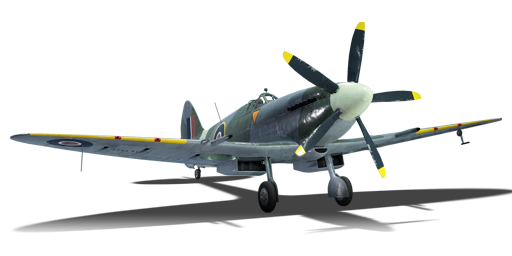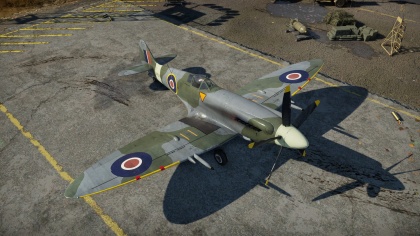Spitfire F Mk XIVc
Contents
| This page is about the premium British strike fighter Spitfire F Mk XIVc. For other uses, see Spitfire (Family). |
Description
The Spitfire F Mk XIVc is a Rank IV premium British fighter
with a battle rating of 4.7 (AB), 5.7 (RB), and 5.3 (SB). This aircraft was introduced in Update 1.41. It costs 7,000 Golden Eagles.
General info
Flight Performance
| Characteristics | |||||||
|---|---|---|---|---|---|---|---|
| Stock | |||||||
| Max Speed (km/h at 8,537 m) |
Max altitude (meters) |
Turn time (seconds) |
Rate of climb (meters/second) |
Take-off run (meters) | |||
| AB | RB | AB | RB | AB | RB | ||
| 691 | 673 | 12000 | 18.6 | 19.0 | 16.4 | 18.8 | 400 |
| Upgraded | |||||||
| Max Speed (km/h at 8,537 m) |
Max altitude (meters) | Turn time (seconds) | Rate of climb (meters/second) |
Take-off run (meters) | |||
| AB | RB | AB | RB | AB | RB | ||
| 768 | 726 | 12000 | 17.0 | 17.3 | 36.9 | 24.3 | 400 |
Details
| Features | ||||
|---|---|---|---|---|
| Combat flap | Take-off flap | Landing flap | Air brakes | Arrestor gear |
| X | X | ✓ | X | X |
| Limits | ||||
|---|---|---|---|---|
| Wing-break speed (km/h) |
Gear limit (km/h) |
Combat flap (km/h) |
Max Static G | |
| + | - | |||
| 794 | 260 | N/A | ~13 | ~8 |
| Optimal velocities | |||
|---|---|---|---|
| Ailerons (km/h) |
Rudder (km/h) |
Elevators (km/h) |
Radiator (km/h) |
| < 321 | < 400 | < 470 | > 250 |
| Compressor (RB/SB) | ||
|---|---|---|
| Setting 1 | ||
| Optimal altitude | 100% Engine power | WEP Engine power |
| 4,600 m | 1,510 hp | 2,129 hp |
| Setting 2 | ||
| Optimal altitude | 100% Engine power | WEP Engine power |
| 8,600 m | 1,320 hp | 1,824 hp |
Survivability and armour
- 42.8 mm Bulletproof glass in front of pilot.
- 12.7 mm Steel plate between fuel tanks.
- 4 mm Steel plate on pilot's seat. Behind pilot is another 6-7 mm steel plate.
- 3 mm Steel plates around ammunition.
- Critical components located at the front of aircraft (fuel, pilot, engine, controls)
- More fuel tanks located in wings near the fuselage
Armaments
Offensive armament
The Spitfire F Mk XIVc is armed with:
- 2 x 20 mm Hispano Mk.II cannon, wing-mounted (120 rpg = 240 total)
- 4 x 7.7 mm Browning machine guns, wing-mounted (350 rpg = 1400 total)
Suspended armament
The Spitfire F Mk XIVc can be outfitted with the following ordinance:
- Without load
- 1 x G.P. 500 lb Mk.IV bomb
Usage in the battles
The Spitfire F Mk.XIVc is the pinnacle of dogfighting at mid to high altitude. Primarily a fighter, this plane excels at catching unsuspecting pilots still climbing to altitude and amazing at the spitfire trademark of dogfighting.
Vehicle characteristics
While it does use the older wing and body type of pre-Griffon Spitfires, this aircraft takes the best of both worlds and becomes a monster at its rank. Utilizing the powerful Griffon engine, this plane has amazing acceleration and climb rate, even better than the Merlin variants. This aircraft does not compromise on maneuverability as it can still turn on a dime. Beware of the brittle wing construction as taking hard G turns at 600+ kph can break its wings.
Tactics
This aircraft has an ideal operating altitude of between 4,000 m - 6,000 m due to the properties of the Griffon engine, but this aircraft has no problems climbing past that altitude, though maneuverability is slightly compromised at altitudes higher than 7,000 m. This aircraft excels at energy dog fighting, a mix between energy fighting and dog fighting. The insanely good acceleration coupled with the great climb rate and energy retention allows this aircraft to excel in horizontal dog-fighting as well as vertical energy maneuvers. Don't get into extended energy fights as many pure energy fighters can outdo this aircraft in pure energy fights.
Specific enemies worth noting
American aircraft can really outdo this plane in speed and energy retention, but cannot dogfight this plane very well. German planes are even more dangerous due to their high top speed and energy retention. This plane can adequately fight Japanese aircraft, but Zeroes can turn faster than you can, though they don't accelerate in a straight line as fast. If you stay up above 4,000 m, you can deal with most Soviet aircraft effectively.
Counter-tactics
Booming and zooming and pure energy fights are this thing's weakness, it does not hold up well in drawn out fights of speed.
Pros and cons
Manual Engine Control
| MEC elements | ||||||
|---|---|---|---|---|---|---|
| Mixer | Pitch | Radiator | Supercharger | Turbocharger | ||
| Oil | Water | Type | ||||
| Controllable | Controllable | Not controllable | Controllable | Combined | Controllable | Not controllable |
Modules
| Tier | Flight performance | Survivability | Weaponry | ||
|---|---|---|---|---|---|
| I | Fuselage Repair | Radiator | Offensive 7.7 mm belts | ||
| II | Compressor | Airframe | Offensive 20 mm belts | ||
| III | Wings Repair | Engine | New 7.7 mm MGs | HMBC Mk.2 | |
| IV | Engine Injection | Cover | Mk.II year 1943 | ||
All modules are purchased due to it being a premium plane.
Pros and cons
Pros:
- Famed Hispano Mk.II's provide excellent damage in tandem with the Air targets belt
- 7.7 mm Tracer belt can help with aiming, as the Browning's and the Hispano's have similar muzzle velocity
- Great turning ability
- Effective climb rate
- Solid Silver Lions and Research Points farmer
- Smaller repair costs than normal tree variant
- Excellent accelleration
- Air Targets belt are stealth (AB)
- Extremely powerful Rolls-Royce Griffon engine provides solid medium to high altitude performance
- Above-average roll rate at medium speeds
- Can equip a single 500 lb bomb for ground pounding
- Has relatively no trouble when being up-tiered
Cons:
- Its characteristics are not as refined as the normal tree variant.
- As with all Spitfires, it has an airframe that is very vulnerable to battle damage
- 7.7 mm Brownings have low stopping power and are woefully inadequate at this rank
- Air Targets belt are stealth (RB/SB)
- Stiffens up at higher speeds
- Carrying the 500 lb bomb is a waste of the plane's dogfighting potential
History
The Supermarine Spitfire Mk.XIV was a single engine, single seat fighter which served with the Royal Air Force during the Second World War. In 1941 the Spitfire Mk.IV was the first Spitfire to be trialed with the new Rolls Royce Griffon engine. By the time the Griffon Spitfire entered service with the RAF in February 1943, subsequent modifications had redesignated the aircraft as the Spitfire Mk.XII. As successful as this new Spitfire was at low altitudes, the Mk.XII’s performance was actually inferior to the Merlin engine Mk.IX at medium and high altitudes. Thus, the Spitfire Mk.XIV entered service as an interim fix. Fitted with a Rolls Royce Griffon 65 with two-stage supercharger producing 2050 hp, the Mk.XIV immediately corrected many of the performance shortcomings suffered by the Mk.XII. The fuselage was strengthened to harness the powerful engine and a five bladed Rotol propeller replaced the earlier four bladed examples. Early models were fitted with the Type C wing although later Mk.XIVs were equipped with the Type E wing housing two 20mm Hispano cannons and two .50 caliber Browning machine guns or four 20mm cannons, as well as a high visibility teardrop canopy. A common modification to the Mk.XIV was the clipped wing, which increased roll rate and gave a marginal increase to speed, but at the most of rate of climb.
The Spitfire Mk.XIV entered service with Nos. 91, 322 and 610 Squadrons in southeast England where it saw notable success as an interceptor against V-1 Flying Bombs but also as part of the 2nd Tactical Air Force in operations over occupied Europe. Spitfire Mk.XIVs were also planned for use in the Far East but whilst a number of airframes were shipped to Burma, none were operational before the end of the war. The Spitfire Mk.XIV met mixed reviews from its pilots; whilst there was no doubt of the huge performance increase the new variant offered, it was uncomfortable to fly and lacked the balance and control harmonization of earlier Merlin engine Spitfires. Just under 1000 Spitfire Mk.XIVs were produced with exports being employed by the Air Forces of India, Belgium and Thailand.
Media
An excellent addition to the article will be video guides, as well as screenshots from the game and photos.
Read also
Links to the articles on the War Thunder Wiki that you think will be useful for the reader, for example,
- reference to the series of the aircraft;
- links to approximate analogues of other nations and research trees.
Sources
Paste links to sources and external resources, such as:
- topic on the official game forum;
- page on aircraft encyclopedia;
- other literature.





